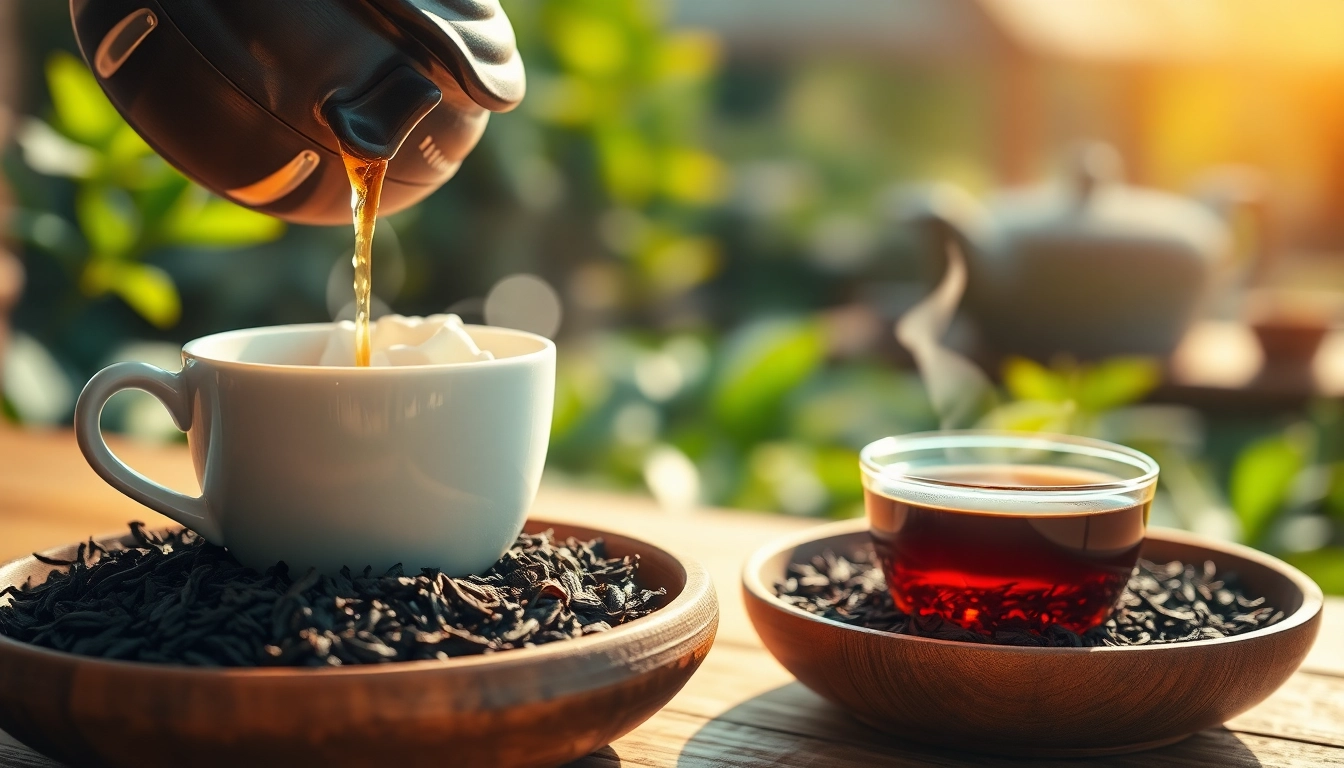Understanding Loose Leaf Black Tea
What is Loose Leaf Black Tea?
Loose leaf black tea differs significantly from traditional bagged tea in terms of quality, flavor, and brewing capacity. This style of tea consists of whole or larger fragments of tea leaves, which not only preserve the essential oils and flavors but also allow for a fuller infusion during brewing. Unlike tea bags, which often contain dust or fannings (the small broken pieces of tea leaves), loose leaf black tea ensures that you are consuming the highest-quality ingredient, contributing to a much richer and authentic taste experience. These teas come from the Camellia sinensis plant, from which all true teas are derived, and undergo various levels of oxidation, which gives each type of black tea its unique character and taste profile.
The Health Benefits of Loose Leaf Black Tea
Loose leaf black tea is not only a source of comfort and enjoyment, but it also boasts numerous health benefits. Here are some of the most notable:
- Rich in Antioxidants: Black tea is loaded with polyphenols, which are antioxidants that can help protect the body from the damaging effects of free radicals. Regularly consuming these antioxidants may help reduce the risk of chronic diseases.
- Heart Health: Studies suggest that regular consumption of black tea can improve cholesterol levels and promote heart health by reducing the risk of stroke and heart disease.
- Enhanced Mental Alertness: The caffeine content in loose leaf black tea, coupled with the amino acid L-theanine, can enhance focus and improve cognitive function.
- Weight Management: Some research indicates that black tea can aid in weight management by boosting metabolism and enhancing fat oxidation, making it a suitable option for those looking to manage their weight.
How Loose Leaf Differs from Tea Bags
The differences between loose leaf black tea and tea bags are vast and critical for tea enthusiasts. Firstly, the processing of loose leaf tea retains larger leaf sizes, which results in better flavor extraction and a higher quality brew. Tea bags, conversely, often contain lower-grade tea remnants, which can lead to a bland and less aromatic infusion. Secondly, when brewed correctly, loose leaf tea provides a more robust flavor profile, allowing drinkers to enjoy the complexity of different varieties. The ability to control the amount of tea used also means that you can customize the strength of your brew, a flexibility that is largely missing with pre-packaged tea bags. Ultimately, those who value flavor and quality will find loose leaf black tea to be the superior choice. For those interested in exploring this world, loose leaf black tea offers a vast array of options to suit every palate.
How to Brew Loose Leaf Black Tea
Essential Brewing Tools
To brew perfect loose leaf black tea, having the right tools can make all the difference. Here’s a list of essential items:
- Tea Infuser: A high-quality infuser will allow tea leaves to expand and release their flavor fully.
- Teapot or French Press: Both are excellent for brewing loose leaf tea, allowing enough room for the leaves to expand.
- Kettle: A good kettle with temperature control ensures you can heat water to the precise temperature recommended for black tea.
- Measuring Spoon: For consistency, a measuring spoon can help you gauge the right amount of tea leaves.
- Timer: Timing is crucial to avoid overly bitter tea; a timer helps ensure that steeping times are adhered to.
Perfect Brewing Techniques
Brewing loose leaf black tea can be a simple delight with the right techniques. Follow these steps for the best results:
- Measure the Tea: Use about 1 teaspoon (or 2.5 grams) of loose leaf tea per cup (8 ounces) of water.
- Heat the Water: Black tea typically brews best in water heated to around 205°F (96°C). A thermometer can ensure the temperature is just right.
- Steep: Pour the hot water over the tea leaves and let them steep for 3 to 5 minutes, depending on the desired strength.
- Taste Test: After the steeping time, taste the tea. If it’s to your liking, remove the leaves; if it’s not quite strong enough, steep a bit longer, checking every 30 seconds.
Common Mistakes to Avoid
Even the most avid tea-drinkers can make mistakes during the brewing process. Here are some common pitfalls to avoid:
- Incorrect Water Temperature: Brewing with water that’s too hot can lead to bitterness, while water that’s too cool can result in weak flavor.
- Over-steeping: Leaving tea to steep for too long can lead to overly strong and bitter flavors. Monitor closely!
- Using Bad Quality Tea: Always select high-quality loose leaf tea, as the quality directly affects the flavor and health benefits.
Types of Loose Leaf Black Tea
Popular Varieties: Assam, Darjeeling, and More
The world of black tea is rich and diverse. Some of the most popular varieties include:
- Assam: Known for its bold, brisk flavor and malty notes, Assam tea is perfect for breakfast blends.
- Darjeeling: Often referred to as the “Champagne of teas,” this variety offers floral and fruity notes and is lighter in body.
- Ceylon: Originating from Sri Lanka, Ceylon teas offer vibrant flavors with citrus notes, making them refreshing.
- English Breakfast: A robust blend of black teas, it’s great with milk and sugar for a hearty breakfast.
- Earl Grey: Flavored with bergamot oil, this tea is distinctively aromatic and soothing.
Flavor Profiles of Different Black Teas
Understanding the flavor profiles of various black teas can enhance your tasting experience. Here’s a brief overview:
- Assam: Characterized by a rich, robust flavor with malty sweetness, it’s fantastic for those who prefer a stronger brew.
- Darjeeling: Offers a light, floral aroma with hints of muscatel. Best served without milk.
- Ceylon: Bright and lively with a hint of sweetness, it’s incredibly versatile in both hot and iced forms.
How to Choose the Right Type
Choosing the right type of loose leaf black tea depends largely on personal preference. Consider the following factors:
- Flavor Preferences: If you enjoy rich, bold flavors, go for Assam; for something lighter, opt for Darjeeling.
- Time of Day: Stronger teas like English Breakfast are ideal for mornings, while floral teas can be enjoyed throughout the day.
- Pairings: Think about what you’ll pair your tea with; robust black teas can stand up to hearty meals, while lighter varieties complement pastries and lighter fare.
Storing Loose Leaf Black Tea
Best Practices for Tea Storage
Proper storage is crucial for maintaining the freshness and potency of your loose leaf black tea. Here are the best practices:
- Use Airtight Containers: Store your tea in airtight containers to prevent exposure to air, which can degrade the quality.
- Cool, Dark Place: Keep tea away from direct sunlight and heat. A cool drawer or cupboard is ideal.
- Labeling: Always label your containers with the type of tea and date of purchase to keep track of freshness.
How to Maintain Freshness
To keep your loose leaf black tea fresh:
- Avoid moisture and humidity; use a dehumidifier in the storage area if necessary.
- Avoid storing tea near spices or strong odors, as tea can easily absorb these scents.
- Revisit quality every few months, and if you notice changes in aroma or taste, consume it sooner rather than later.
Signs of Spoilage in Black Tea
It’s vital to recognize when black tea has gone bad. Here are signs of spoilage to watch for:
- Loss of Aroma: Fresh tea should have a vibrant scent; if it smells flat or stale, it’s time to discard it.
- Discoloration: Tea should maintain its original color; faded or discolored leaves signify spoilage.
- Unpleasant Taste: If brewed tea tastes off or lacks flavor, this can indicate that it has degraded.
Where to Buy High-Quality Loose Leaf Black Tea
Online Retailers for Premium Teas
Purchasing loose leaf black tea online offers an extensive variety from around the world. Some trusted online retailers include:
- Specialty Tea Websites: Sites like TeaSource and Numi Tea showcase a range of options from high-quality sources.
- Health Food Stores: Websites for health food brands often provide a selection of organic and sustainably sourced options.
- Direct from Growers: Purchasing directly from tea estates can offer fresher and more authentic products.
Local Stores and Specialty Shops
If you prefer in-person shopping, many specialty tea shops are laden with selections worth sampling:
- Tea Houses: Local tea houses often provide a cozy atmosphere and knowledgeable staff to help guide your purchases.
- Gourmet Grocery Stores: Many upscale grocery stores carry a selection of loose leaf teas that allow you to try before you buy.
Choosing Sustainable and Organic Options
For environmentally conscious consumers, seeking out organic and sustainably produced teas is key:
- Look for Certifications: Look for teas with organic certification or fair trade labels to ensure ethical sourcing.
- Research Brands: Investigate brands that prioritize sustainability in their farming practices and packaging.
- Seasonal Varieties: Choose seasonal teas, as they are often fresher and made from quality harvests.


